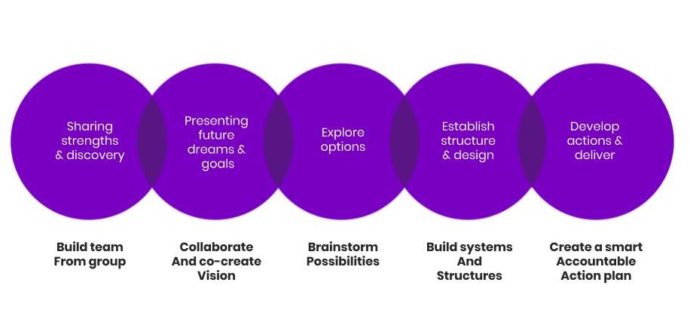Vision of leaders needs the muscle of teams to fulfill.
Teams function well when then they have ownership in decision making in addition to factors of safety, trust, and relevance of objectives. Leadership decisions taken without involvement of team inputs have less chance of succeeding than those taken in consultative involvement.
Increasing diversity, accelerating change and the millennial disrespect for authority make directive top down decisions splutter and fail. A collective approach of co-created vision, consultative decision and collaborative action through emotionally engaged teams is a sure fire recipe for success. “What?” and “Why?” of this logic cannot be disputed. The question to answer is “How?”.
Collective Vs Individual
The first to articulate the concept of collective visioning was Carl Jung, through his Collective Unconsciousness concept. Jung veered away from Freud, stating that the Unconscious is not a negative space comprising negative thoughts and intentions, but a positive space arising from a superior intelligence, which knows what works best for the individual and collective group.
Those familiar with Eastern spirituality would recognize this as a fundamental tenet of Hindu Buddhist philosophy, in which the individual’s righteous action always takes cognizance of the collective need and view, generally called dharma.
Since Carl Jung, Carl Rogers (through his Client Centered Approach), Grinder and Bandler (through NLP), David Copperrider (through Appreciative Inquiry), Kathleen Dannemiller (through Large Scale Interactive Proces, Martin Seligman (through Positive Psychology), and many others, added great value to this concept. Their works show that when individuals get involved in the decision making process, outcomes exceed expectations both for individuals and organizations.
In another blog on Collective Coaching, we referred to Project Aristotle of Google and Lencioni’s work on functions and dysfunctions of teams.
The effect of individual involvement in co-creation of decisions works at multiple levels.
1. First, each individual working alone creates his or her own mind map, often at variance with even those who share a collective responsibility. Simply put, collective responsibility does not translate into collective vision, or into individual responsibility. The organization and its leaders may lay down their own vision to apply to each individual in the organization, but experience shows that people need not, and often do not, buy into this vision. Misalignment results. Management practices such as the Japanese ringgi try to avoid this dilemma by involving each member of the team in decision-making. Decision-making may be slower, but the overall implementation time becomes shorter when the team buys in.
2. Second, when properly managed, group synergies can produce better results than individual inputs separately coordinated. US automakers discovered this painfully when marketing, design, and manufacturing groups operated in silos, and threw their ideas across isolated and unconnected structures, resulting in customer unfriendly products, almost killing the US auto industry. Collaborative design and manufacturing changed their balance sheets and profit & loss statements.
3. Third, when facilitated well, groups develop emotional connect between individuals. This can raise the good to great.
I have deliberately used the phrases ‘when properly managed’ and ‘when facilitated well’. The concept that collective effort works better than individual inputs resonates as common sense, but the process of applying this concept to groups needs skill. Without a coach familiar with group facilitation and team coaching, teams can create camels!
Making groups work as teams
In my experience, individuals working in groups strive better seeking to give out their best and produce remarkable results under the following conditions:
- Working towards a meta objective with thematic and emotional content
- Acting in an uplifted emotionally bonded state
- Developing on their strengths supported by appreciation
- Sharing experiences, stories, legends and metaphors
- Feeling of being in control and in ownership of a co-created solution
- Creating through the right brain where possible
Success of the team coach depends on the ability of the coach to generate the following within the group:
- Emotional bond
- Awareness of issues involved from an organizational perspective
- Positive and appreciative communication
- Accountability to deliver a superior outcome
- Balancing right and left brained approach in developing a creative solution with a practical structure.
SPEED Collective Coaching Process
Organizations may require a challenge to be resolved, a project to be planned, inspired motivation to act, or even a fuzzy future to concretize. Simply put, it is the intent that the group works from towards its desired outcome. As in a coaching contract, the client, who in this case comprises the organization and its collective leadership team, needs to define the present issue and the desired outcome.
We combine the GROW model commonly used in coaching, with the 4 D process of Discovery, Dream, Design and Deliver used in Appreciative Inquiry and LSIP processes, in developing the process Coacharya uses. This SPEED coaching process comprises 5 stages of:
1. Sharing Strengths
2. Presenting Future
3. Exploring Options
4. Establishing Structure
5. Developing Action
Sharing Strengths
In this stage of speed coaching, the Coach focuses on building out of a group a team bonded emotionally through a shared vision.
Teams need a thematic objective or shared vision that fulfills organizational needs appealing to emotional needs of team members. Numbers alone as targets would be unproductive in any co-creative exercise. As with any good marketing and advertising effort, the sponsor and the coach need to develop a realistic and appealing story line for the group to work on. Coach presents this story to the group.
This stage, as with the Discovery stage in an Appreciative Inquiry or LSIP process, works on individuals bonding with one another emotionally. Collective coach invites each member of the group to share with others answers to three questions.
- What is your understanding of organizational objective?
- What role can you play in achieving this objective?
- Share a personal experience where you exhibited and experienced an inherent strength in a powerful manner that makes you suitable for the role you plan to play.
The coach encourages the youngest or most recent member of the group to start first, so as not to be inhibited by the views of an older senior member of the group. After each sharing, one by one, other members of the group acknowledge the sharer’s experience, appreciate and celebrate.
As the sharing continues, one can sense the team emerging from the group. In several groups, members openly admit to this stage as their first experience of appreciation in the organization. In the past, when they performed well, the organization or managers took that for granted. When they made mistakes, criticism followed. Appreciation rarely fitted into the culture of many organizations. As collective appreciation proceeds in the first stage of the SPEED process, group members become connected emotionally and form a team. This combined with the systemic organizational objective makes the process collective.
This team building process needs time. Typically, we allow a minimum 15 minutes/person for a group of 10, and 30 minutes/ person for a group of 20. Larger the group size, longer the time the coach needs in order to allow each group member to contribute with each sharer. The Sharing stage alone may take a whole day with a group of 20!
The coach should encourage emotional sharing through appropriate questioning as needed. This creates self-awareness within the sharer and bonding with the group. The entire approach works on positive psychology. People share their strengths and others support them appreciatively. No room exists here for criticism and doubts.
During the sharing Coach asks both the person sharing and the witnessing group exploring and evocative questions that address the team as a whole. Coach treats the team as the client, the invisible thousand pound gorilla, whose presence needs to be brought out. Coach’s questions with address the mindset of the team as a whole, the ‘who’, and the situation from which the team would move towards the desired outcome, the ‘what’.
From time to time, there may be opportunities to address the ’who’ of the individual, and the coach needs to ensure that this relates to the team. Any individual behavioral issue is noted and addressed outside, unless the team as a whole wishes to address it in the present moment.
Presenting Future
From team building, the coach now moves to business as the second step. A senior member of the organization expands the shared vision into a more detailed storyline, either as a problem for resolution or a vision to aim for. This person explains the current situational reality and the desired outcome, as a contract in a classic coaching session. The team moves from Present reality to a Vision for the Future.
The coach divides the team into smaller groups of 3 or 4, and each small group develops its version of the desired future vision. This stage of speed coaching corresponds to the Dream stage in AI or LSIP. The groups disregard resource constraints of time, manpower and money in developing its dream. Groups work creatively, and the coach provides them with papers, crayons, old magazines, scissors and stuff to develop right brained presentations depicting their vision. This session followed by a presentation of about 10 minutes by each group and appreciative discussion would take 2 hours.
As each sub group presents its future vision, the coach categorizes the main points under common categories. Generally, 6 to 10 main categories emerge from the Presenting Future session. The coach then rearranges the groups by shuffling members to form another set of sub groups for the next SPEED session.
Exploring Options
Exploring Options, the third stage of speed coaching, adds value in moving from the creative Presenting Future stage to practical realities of Structure and Action that follow. The reconstituted sub groups start with the categories arising out of the Presenting Future session, to develop options that would fit their organization culturally and structurally.
We find this a critical stage to reframe the Presenting Future ideation of vision into actionable alternatives, viewed through the prism of pragmatism. Experience with AI and LSIP showed us that while these worked with large voluntary groups in developing a few common points for organizers to build on, corporate team demanded a far more structured solution arising out of broader exploration.
For instance, in a SPEED session developing the next 3-year action plan of a consumer goods company, based on a thematic vision of introducing sustainability and environmental sensitivity into the organization, along with growth in top and bottom line, one of the outputs in the Presenting Future stage was ‘elimination of plastic in packaging’.
In this Exploring Option stage, this idea was discussed at far greater length in terms of viable options of alternative materials, issues of sourcing, product life etc. The coach allows about 2 hours for this stage.
Establishing Structure
Once the sub groups have Explored Options arising out of ideas for the Future, they move to the fourth stage of speed coaching i.e Establishing Structure, in terms of organization, resources, and budgets necessary to produce the desired results. Coach may wish to form groups of functional expertise for this session.
Most corporate groups have familiarity with this process. In some cases, boundaries, or limitations to additional resources, may be set by the coach, in line with organizational requirements. This stage would take 3 hours.
Developing Action
In this last and crucial stage, the team takes responsibility and accountability for all that it has created thus far. Without a conclusive output in Developing Action, the entire SPEED coaching process would be a waste of time.
Each of the actionable ideas that came up through these earlier processes should now be time lined with individual responsibilities in a SMART (Specific, Measurable, Actionable, Realistic, Timeline) format. This last session would be individual for 30 minutes.
Even if the team cannot conclude this part in a one or two day session, either because of time constraints or because not all people needed for final action form part of the team, enough of an actionable plan must arise out of this stage, with a commitment from the team members to work with teams of their own to develop an organization wide implementable time based action plan.
Generally, with a team of 20, SPEED Collective Coaching process would take 2 days. We have conducted these programs successfully for groups of 10 in one day.
Some Thoughts to Share
To read and understand this as one more visioning exercise, or an action plan development exercise, would be missing the philosophy of this process.
- The first stage of Sharing Strengths can be a Team Building exercise, and in the SPEED process helps co-create and co-own decisions.
- The first three stages of SPEED work with the right brain non- analytically to enable the team break out of the box. The coach should master this facilitation.
- The last two stages, Establishing structure and Developing Action, seem more analytical than the earlier three, and yet, the coach can make this process interactive and co-creative through collective coaching inputs both with sub groups and the larger team. The coach needs to ensure that team shares the process of co-creation and co-ownership.
In our experience, coaching individuals is not the most effective way of leadership development in organizations. Individuals need to work with an environment in which they need support after coaching. Collective coaching helps create a support system within organizations, helping a powerful link in aligning individuals to groups and groups to organization.
Organizations can set larger level goals with ROI parameters for the group to work on, along with development goals for participating individuals based on 360 feedback surveys, psychometric tests and performance reviews.
Application
- Leadership Development through co-visioning to collaborative action
- Team Building through appreciative collective coaching
- Ideal for strategy sessions to set Objectives and Key Results (OKR)
- Culture Change
Cases
- Growth stage IT company seeking a collective consensus on vision
- New division seeking team to be built around an external leaders
- Morale building in a decimated MNC subsidiary
- Culture change to enhance performance in line with MNC OKR
- Start Up to develop co-created vision to collaborative action
- Not for profit to align organizational objective with individuals
Beyond SPEED
SPEED process as the starting point of the collective coaching journey is best done face to face in a company setting. The collective coaching journey is typically of 12 monthly sessions, each at least 2 hours, lasting a year. The journey comprises these actions.
- Team develops an action dashboard for follow up based on output from SPEED coaching session with one person as the coordinator to schedule future meetings, circulate progress and action memos
- Monthly collective coaching sessions address progress and hurdles
- Some individual coaching needs surface by observing team dynamics and are addressed with permission from organization
- In a 12 month journey, feedback and feed-forward sessions with key organizational stakeholders outside the team joining the team once every 3 months
- Documented case study for internal use




